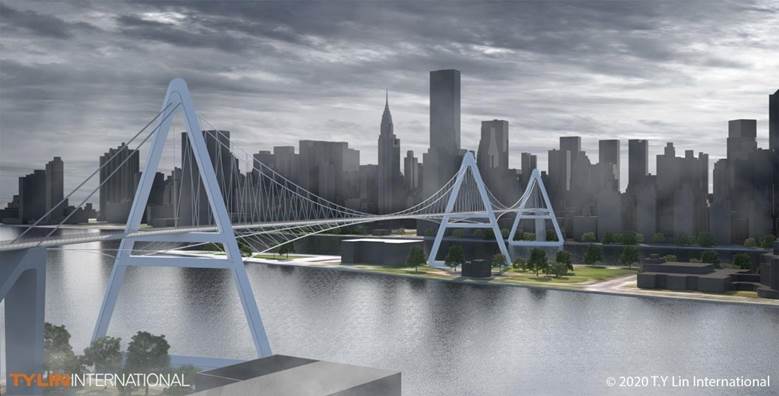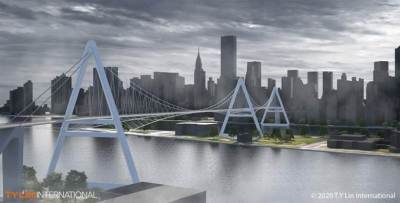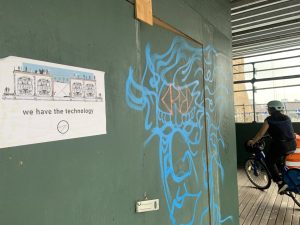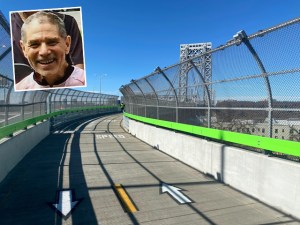Advocates Cool to Proposed Cyclist, Pedestrian Bridges
Gridlock Sam's idea is good, but money would be better spent on fixing existing spans, they say.

A noted transportation expert is advancing a visionary proposal to build three new pedestrian-and-bike-only bridges into the core of Manhattan — two across the East River, and one across the Hudson — in an effort to address the surge in cycling because of the COVID-19 crisis.
Samuel “Gridlock Sam” Schwartz, a spearhead of congestion pricing and an intellectual leader and advocate for decades in the the livable-streets movement, unveiled his idea for three new car-free spans on Wednesday — one each from Queens, Brooklyn, and New Jersey — which would head into Manhattan’s Central Business District and could handle about 20,000 people a day. The proposed “ribbon” bridges — so named because of their 20-foot wide bridge deck and stress-ribbon engineering — would cost $100 million apiece, less than half of the construction of the popular High Line, and about a hundredth of what it would cost to build a subway line.
Advocates, however — taxed by the pandemic and leery of the city’s precarious finances — are reacting cooly to the idea, preferring that the city take space away from cars on existing spans in order to make way for dedicated bike paths, as they have demanded for years. Spending hundreds of millions when the city is so financially unstable that Mayor de Blasio may be forced to axe 22,000 workers, and has eviscerated the budgets of the Department of Transportation and other agencies, is unreasonable, in their thinking.
“What if we just took some lanes from all the pre-existing bridges instead and had at least one wide and safe bike route into Manhattan at the expense of two of the gazillion lanes for cars?” said Ben Kabak of the prolific Second Avenue Sagas. “Don’t make this more complicated than it needs to be.”
What if we just took some lanes from all the pre-existing bridges instead and had at least one wide and safe bike route into Manhattan at the expense of two of the gazillion lanes for cars?
Don't make this more complicated than it needs to be. https://t.co/eCnriJxl7P
— Second Ave. Sagas (@2AvSagas) June 24, 2020
In this view, the city should follow through on longstanding demands to convert the Queensboro Bridge’s southernmost car lane, also known as the South Outer Roadway, into a pedestrian path so that bicyclists and pedestrians no longer have to share the narrow North Outer Roadway — a years-long problem that’s only worsened during the cycling boom as many New Yorkers avoid public transit.
The Schwartz proposal comes as the influential Regional Plan Association fielded a blueprint for a five-borough bikeway that would serve as a central spine for the city’s growing bike network, and as cycling has soared since the early days of the pandemic — weekend bike trips across the East River have increased by 62 percent so far this month, compared to June 2019, according to DOT.
“It’s not a bad idea. It’s just going to take lots of time and lots of money to build,” said Joe Cutrufo of Transportation Alternatives of Schwartz’s ribbon-bridges plan. “The first priority should be pedestrianizing the South Outer Roadway on the Queensboro Bridge. They can do this practically overnight, and double the amount of space for walking and cycling between Queens and Manhattan. More right of way for pedestrians and people on bikes is good. But pick the low-hanging fruit first.”
Bike New York’s Jon Orcutt said that cyclists shouldn’t have to wait years for their own safe space to cross the East River from Queens into Manhattan when the city could seemingly solve the problem overnight.
“We’re experiencing a bike boom TODAY. It’s sad that we as a city didn’t seize the low-traffic moment this spring to show the benefits of separate bike and walking lanes on the Queensboro Bridge,” Orcutt said.
We could unstick the Queens-Midtown ? trip for very little cost by converting the Queensboro Bridge south roadway to a walkway and dedicating the north roadway for bikes only #morespaceqbb. The city wasted a chance to demonstrate it during this spring’s low traffic lockdown https://t.co/i07J3bIQUw
— Bike New York (@bikenewyork) June 24, 2020
On the Brooklyn Bridge, city officials for years have failed to fix dangerously congested conditions on the shared foot and bike path. DOT Commissioner Polly Trottenberg disclosed earlier this year that the agency had failed even to begin a study preparing for work on expanding the pedestrian/cycling promenade. DOT reps said this week that they may give a fresh look at the idea of building a bike lane on the bridge’s roadbed, despite earlier Trottenberg dismissals of the idea.
Trottenberg again warned on Wednesday that the ages of the Queensboro and Brooklyn bridges — both spans date back more than a century — would make it difficult to convert car lanes into safe bike lanes.
“Clearly we have some pinch points at East River bridges, particularly the Brooklyn and Queensboro, where bikes don’t have their own separate space,” Trottenberg said during Mayor de Blasio’s daily press briefing. “One challenge we have with both bridges is they’re very old bridges, the lanes are very narrow, the engineering to create enough space for bikes safely is challenging.”
Trottenberg said that she appreciated the creativity of Schwartz’s three “ribbon” bridge proposals and would look at them with her team.
“Sam, he acknowledges that to some degree, 100-plus year old bridges are hard to retrofit. So perhaps we need some new pedestrian, bike crossings,” she said. “We have budget challenges right now, but I think it’s exciting what he’s put forward and we’ll be engaging with my leadership on it.”
But spending millions of dollars on new bridges that could take years to build should not be the city’s priority now, said Queens transit and biking activist Samuel Santaella.
“The time for dedicated bike/pedestrian bridges has come, and I welcome it,” he said. “But if the Queens Ribbon is merely to address increasing ridership, then existing resources should be taken advantage of first, such as opening the South Outer Roadway to people walking, and other geographic gaps should be filled in with these new bridges. The Queens Ribbon would be last in my personal-priority list.”



